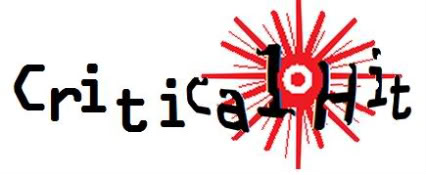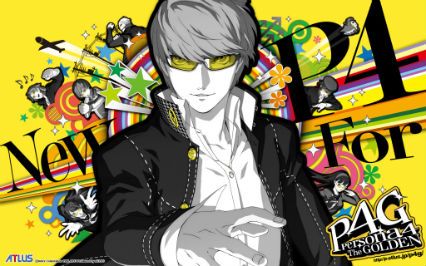- Format: Vita
- Unleashed: February 22nd (EU), Out Now (NA)
- Publisher: NIS America/Reef Entertainment
- Developer: Atlus
- Players: 1
- Site: http://www.atlus.com/p4g/
It’s no exaggeration to say that for the first two hours, this game asks you to do little more than read, listen, and press X. It’s also no exaggeration however to say that, despite some obvious flaws, Persona 4 fully deserves the ferociously obsessive following that makes up the core of its fanbase.
Golden is a handheld remix of the 2008 PS2 release, and much more than a lazy port. Existing fans will be excited to hear that additions include a new character, a new dungeon, one new ‘bad’ ending, and more. The graphics have been given an overall polish and tidy-up, and don’t look particularly dated under the ruthless magnifying glass of the Vita’s OLED screen (though the occasional motion blur for slow-moving character models remains). New difficulties have also been added at both ends of the scale, catering for both the sadomasochistic super-hardcore, and the turn-based newbies.
Speaking of newbies, the self-contained story means no previous Persona experience is necessary to understand or enjoy the game. Your mostly mute character (who you can name something hilariously rude should you so wish) has been sent to stay with his uncle for a year in the sleepy town of Inaba. It’s not long before the first corpse is hung on a TV antenna, and you soon discover that the killings are somehow linked to the ‘Midnight Channel'; an urban legend whereby it is said that by staring into a powered-down TV on a rainy night, you will see your soul mate.

Come on, you KNOW which answer you need to choose here.
There’s another world accessed through TV sets, a dangerous world with a complicated relationship with that of prosaic concerns such as school, noodles, and going to the cinema. The bottom line is that the killer’s victims are thrown into the TV world and, if you don’t rescue them before the mysterious fog of Inaba appears then lifts, they die. This is achieved largely through use of the eponymous Personas. Think Pokémon and you’ll get the idea. Though you can physically attack or use items during the turn-based battles, the most powerful attacks and abilities are usually wielded by the Personas of you and your gradually-growing team of teenage adventurers. They level up as well as you, learn new abilities, and – like your enemies – can succeed or fail due to their elemental strengths and weaknesses (fire, ice, electricity, etc). New Personas can be given as a reward for winning a battle, or ‘fused’ into being when you combine two or more in your possession.
Fighting in the TV world is an integral part of the story and overall experience, but you’ll actually spend most of your time in the totally safe ‘real’ world. This means going to school (including, now and again, actually answering questions), talking and going out with friends, shopping for items to use in the TV world, completing optional (usually fetch) quests, and more. Little, if any, of this is irrelevant filler. As Personas come from a person’s mind – representing their ‘true self’ – and the TV world itself is somehow connected to the human psyche – there’s a lot of psychology at play here. There are almost Psychonauts-style layers to peel away, if you look closely enough. In terms of gameplay however, choosing how to spend your time carefully will reap benefits later. Becoming closer to one of your friends will make them more powerful and/or useful in battle; increasing attributes such as Knowledge and Expression will open up new dialogue options and even relationships; and each relationship is linked to a Persona category. Fuse a Persona in the category of somebody you’re close to, and bonus XP shall be showered upon your creation.
You and your friends aren’t just playing supernatural top trumps – you need to get on with being teenagers who are also battling education and relationships, something excellently brought forward by much of the dialogue and story. That said, Yosuke and Chie (and perhaps Nanako) are arguably the only characters that end up well defined; and the new actress given Chie’s part seems to have provoked a ‘love her or hate her’ reaction from pretty much everybody. This is all forgiveable nonetheless, thanks to some genuinely funny and even touching moments.

Must…resist…”We can lick ’em” joke…
The biggest criticisms to be laid at P4G’s door lie in the dungeons. Each remains, sadly, visually repetitive and dully designed. Worse still there are no autosaves or quicksaves, which would have been more welcome still for a portable title. This can become a problem on the mid to high difficulties, where losing any battle means an instant Game Over. A small mercy is that you can exit a dungeon, save, then re-enter at whichever floor (usually a total of 8-12) you last reached. You are at least given a fair amount of ‘days’ to complete each. However, the ability to change difficulty mid-game before starting New Game Plus would have been greatly appreciated.
The included extras are enough to thrill Persona 4 fanboys and fangirls (the ranks of which are sure to swell with this release). Though the soundtrack CD from the PS2 version is sadly missing, there’s an even more comprehensive music collection hiding in the menus. There are music videos from Persona concerts, a few trailers, a short-but-sweet buzz-in quiz hosted by Teddie, and more.
This is a big game (you’re looking at about 50+ hours for the best ending just on the wimp-out Very Easy difficulty) and most of it is dialogue, or making decisions such as ‘should I take Yukiko to the cinema, or try to catch that fish the old woman wants?’. This isn’t a game for everybody. Make no mistake, though – if P4G does grab you, it will do so with both hands and refuse to let go until you admit that it is, indeed, the daddy. This world is a hypnotic one, where you want to see everything at once and become frustrated when you have time to stop and realise that you’re not able to do so.










Comments